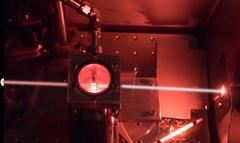URL: https://www.desy.de/news/news_search/index_eng.html
Breadcrumb Navigation
DESY News: Researchers generate the shortest ultraviolet laser pulse ever
News
News from the DESY research centre
Researchers generate the shortest ultraviolet laser pulse ever
Researchers at the Center for Free-Electron Laser Science (CFEL) at DESY in Hamburg have generated a 1.9-femtosecond ultraviolet laser light pulse - setting a record for ultraviolet (UV) laser pulses with the shortest duration. The experiments, published in the recent issue of the scientific journal Optics Letters, outshine the previous record of 2.8 femtoseconds, set in 2010.

The 1.9 femtosecond flash was generated by frequency conversion from infrared light in a gas cell (in the glass block in the center of the vacuum chamber). Photo: DESY/AG Calegari
Generating ultrashort UV pulses has always been a challenge due to the high dispersion of light in this spectral region in air and in materials that are used for their generation. The approach used by the team of Prof. Calegari is frequency up-conversion of 5-femtosecond infrared pulses in a high-pressure laser-fabricated gas cell located in vacuum. This method allows for the shortest pulse duration to be preserved.
“Reaching the sub-2-femtosecond barrier represents an exciting result,” says Prof. Calegari. “By further optimizing the geometry for the pulse generation we could even push the duration down to attoseconds (1 attosecond is a billionth of a billionth of a second), a duration that is typically achieved at higher photon energies.”
The research conducted in the team of Prof. Calegari, in collaboration with the Institute of Photonics and Nanotechnology (IFN-CNR, Milano, Italy) and Politecnico di Milano (Milano, Italy), has been financed by the European Starting Grant STARLIGHT (STeering Attosecond electRon dynamics in biomolecules by UV/XUV LIGHT pulses) and it opens new important perspectives for ultrafast molecular spectroscopy, as a promising tool to reach a deeper understanding of the first instants of UV induced photochemical reactions and bio-damage effects.
Reference
“Generation of deep ultraviolet sub-2-fs pulses”, Mara Galli, Vincent Wanie, Diogo Pereira Lopes, Erik P. Månsson, Andrea Trabattoni, Lorenzo Colaizzi, Krishna Saraswathula, Andrea Cartella, Fabio Frassetto, Luca Poletto, François Légaré, Salvatore Stagira, Mauro Nisoli, Rebeca Martínez Vázquez, Roberto Osellame, and Francesca Calegari, Opt. Lett. 44(6), 1308-1311 (2019), DOI: 10.1364/OL.44.001308
Website of the EU project STARLIGHT



